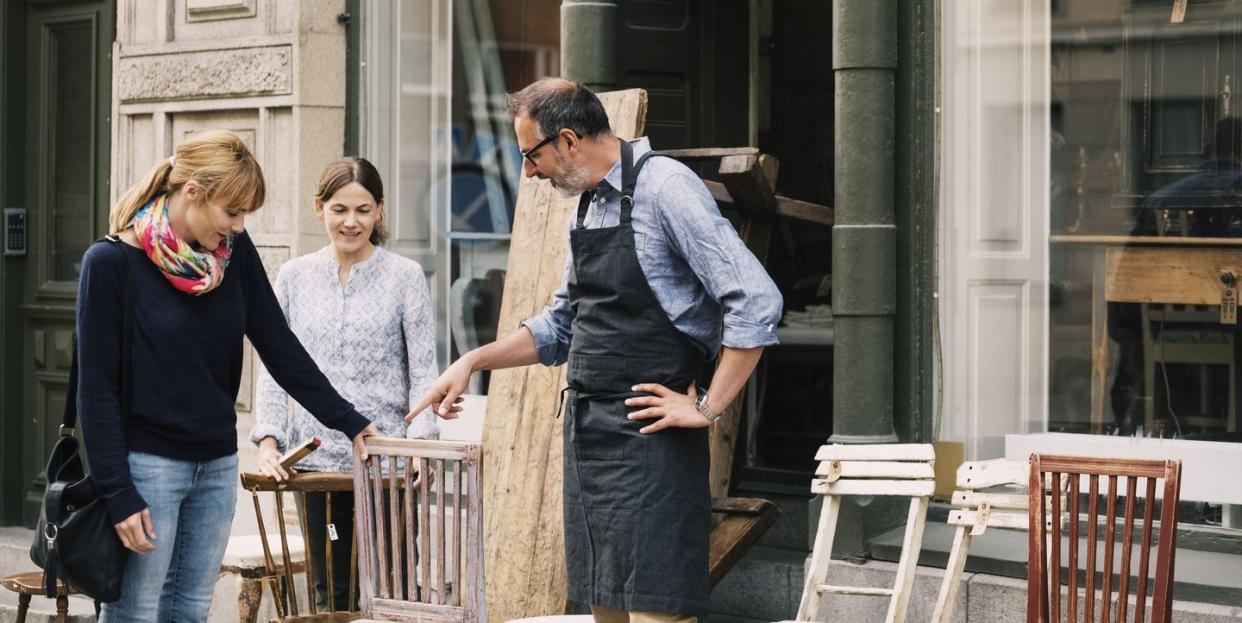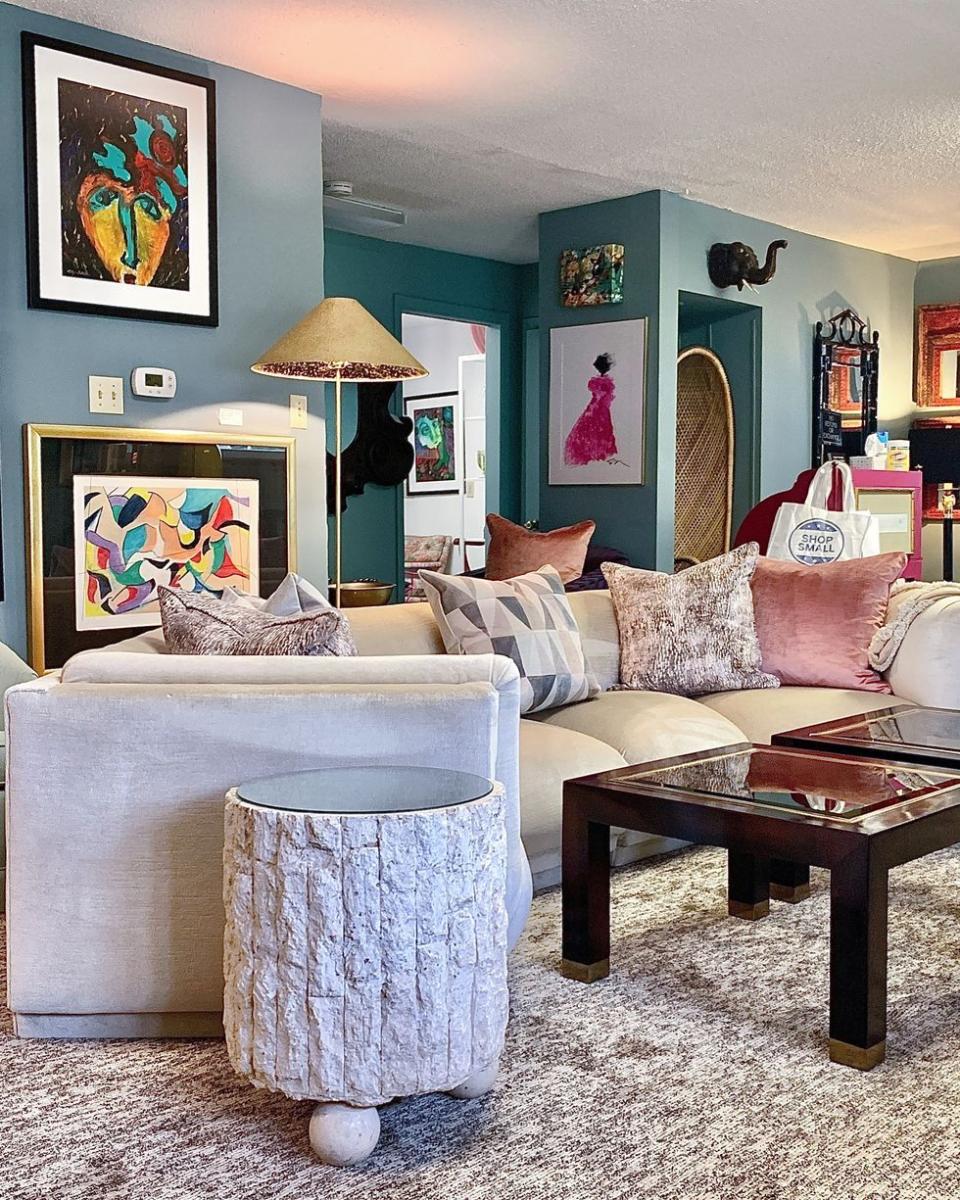How to Make Money Selling Your Used Furniture

“Hearst Magazines and Verizon Media may earn commission or revenue on some items through the links below.”
While we're all about creatively reimagining tired furniture (reupholstery, new stains, or a fresh coat of paint can work wonders!), sometimes it's just time to let a piece go. And you might as well make some money while you're at it, right? Not only is eschewing the dumpster for resale better for your own wallet, it's better for the environment, too. Whether your item is collectible-level or just a sofa you inherited from your roommates, you just may be able to find a new home for it—and earn some cash in the process.
We tapped two experienced experts in resale to share some pointers for the process: Ariene Bethea, owner of vintage shop Dressing Room Interiors Studio in Charlotte, NC (one of House Beautiful's Best Home Stores in America!), who scours the country for great furniture finds, and designer and home stager Leia T. Ward of LTW Design, who both sources and sells styling props and design items online.
Selling furniture requires taking stock of several things: What's your end goal (a huge profit, or just to get rid of something)? How much work are you willing to put in (putting up a passive listing or planning a serious sale)? And how do you envision dealing with logistics (will you list it online and consider shipping, or stick to local buyers)? Read on for a complete breakdown of where to sell, how to list, and what it takes to get the best possible profit.
What condition is your item?
This might determine how you go about selling it. If your piece is damaged or broken, it may not be worth selling on sites that take a percentage of your fee. If it's broken or fragile, it may not be wise (or may be too expensive) to ship. Items that are new, like new, restored, or in well-kept condition are likely to fetch higher prices. Keep this in mind as you decide your list price and how and where you want to sell.
Are you willing to ship?
One of the biggest factors in buying and selling furniture is shipping. If you're not willing to front these costs or to deal with the hassle, you'll want to list your item on a local site, such as your town's Craigslist or Facebook Marketplace (more on those below) or opt for in-person selling. If you've got a lot of furniture to sell, consider hosting a tag sale.
Tips for selling furniture locally:
If you want to host a tag sale, create clear, descriptive signs to hang around your neighborhood at least a few days before your sale. Include address, hours, and any other info.
Considering posting about your sale on online community boards and on social media as well, if you're comfortable sharing your address.
Ensure all furniture is clean and clearly displayed so it's easy to look at from all angles.
If you don't have enough furniture for a sale, look into existing flea markets in your area and see if the cost to participate is worth what you think you'll make (decide that with our tips for pricing, below).
If you want to sell a few high-value items, consider consigning or selling to a local antiques or vintage dealer or an auction house. Contact one in your area to give you an estimate on your item's value and details on selling.
If you are willing to ship your item, your best bet is an online listing that will reach the maximum number of people. Read on for best practices in online listing.

How to Price Your Piece
Whether you're selling in-person or online, you'll want to set a price that's fair enough to get offers but high enough for you to make the maximum profit.
Do your research. Begin with a search for comparable items to get a sense of what they sell for. If your item is unique (say, a rare antique), consider consulting a vintage or antique dealer to get an estimate.
Consider how flexible you are. Do you have a firm price you're aiming for? Are you open to haggling? Consider this when setting your price. If haggling is an option, you might want to set the price on the higher end; if you're looking to list on a bidding site, like eBay, determine your lowest acceptable price and build from there.
Consider additional costs: In addition to the value of your item, you'll want to factor in any additional costs: Will you have to ship and package the item? If so, will you offer free shipping (and in doing so, eat the cost)? Will your item need insurance to transport? Will you offer delivery for a local sale? If so, will that be free? It all factors into the price you set.
How to List Your Item for Sale Online
If you're listing online, you'll want to ensure you're giving a full picture of your item and its quality. Here's what Ariene Bethea recommends:
Make sure not to have the flash on when taking photos (this could lead to discoloration or glare). Instead, find a well-lit place to take a photo during daylight.
Don't use any filters! "You want to represent the piece in its nature state in natural light," explains Bethea.
"Provide all dimensions: length, width, height, depth—and don't forget seat height and arm height" for chairs. Any other relevant dimensions for specific pieces are great to include, too (eg. drawer size for a dresser or nightstand)—the more info the better!
"Get close ups of the pattern, texture, or fabric," says Bethea. These details are important! On a related note, "describe the color as best you can because it appears different on different screens," she points out.
Be up front about any damage—"photograph and identify it clearly," she says.
Be sure to clearly identify the material.
Use as many keywords as possible in your listing and title (Tip: Look for comparable listings online and take cues from the descriptors those use).
Finally, and one that's often overlooked: "Provide imagery of all angles of the piece (front, back, side, inside)."
7 Places to Sell Your Furniture Online
Chairish
Chairish is best for those looking to sell collectible or high-value furniture. The site charges commission (30%), but, thanks to its deep ties to the professional design community, it also offers up a range of buyers willing to spend on big ticket items. "They vet their sellers well so you know the buyers shopping there are serious buyers which increases your chance of selling your product for the highest return," explains Leia T. Ward. Plus, as an established go-to, the company provides selling guidance and help on the back end.
If you're looking to sell furniture as a professional endeavor, you can apply to be a dealer on the high-end sites 1stdibs and Incollect.
AptDeco
If you're new to selling and live on the East Coast, AptDeco might be the best bet for you. The site, which operates in the northeast (check delivery locations here), will guide you through the process of selling, enhancing your photos, suggesting pricing, and supplementing details for your listing. Their professional delivery team will facilitate the handover. AptDeco charges a fee between 25 and 38 percent depending on your sale price.
Ebay
Chances are, you've already heard of eBay—and that's the site's biggest benefit. With an established history and huge traffic, listing on eBay means your furniture will likely get plenty of eyeballs. But that comes with a few downsides, too: Unlike some of the smaller furniture sites, buyers aren't as carefully vetted and you'll be competing with a massive range of listings. That said, eBay offers an established infrastructure, which can provide ease of mind when selling. It is also ideal for items which you want to list in bidding style to get the highest price.
Facebook Marketplace
This is a great option for those willing to invest a bit of time and effort and looking for local buyers. "Facebook takes slightly more management on your end but there are no commissions to pay and the turnaround is fast," says Ward. "We sold some inventory of ours there and made $15k in 3 days!" That said, Ward has some tips to help seal the deal (safely!)
Avoid using your real identity. Instead of creating a page tied to your personal account, Ward advises sellers to "create a page with a generic name for privacy and safety."
"Have them Venmo you in full before you hand anything over," advises Ward, to avoid scams.
Meet in a public location, such as a parking lot.
OfferUp
Another source for local selling, OfferUp lists everything from cameras to car parts. This is a good option for contemporary furniture or pieces without a "special" back story that you'll be selling at a steep discount to the buyer. You'll want to observe the same safety guidelines here as Ward outlined above, but OfferUp does give you the option to message with users and view their profiles so you have a sense of their identity and transaction history.
Craigslist
The most no-frills, basic platform for selling, Craigslist connects local buyers and sellers in an anonymous fashion. It's good if you want to protect your identity and attract local sellers, but you won't get the kind of support or protection offered by other options.
Finally, don't rule out the design world's favorite social media platform when you're looking to sell. More and more vintage dealers are seeing success selling through the platform—which means there are eager buyers out there scrolling! This just may be the lowest-lift option: Simply post a photo of your item, price, and pickup details, and let the algorithm do the rest.
Follow House Beautiful on Instagram.
You Might Also Like

